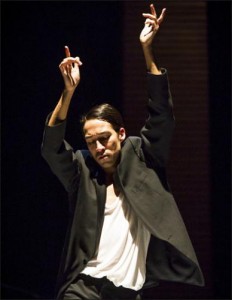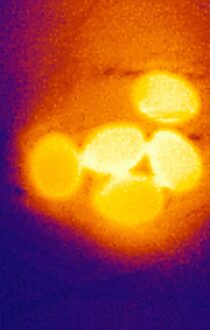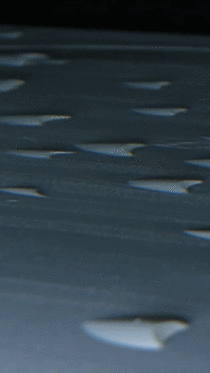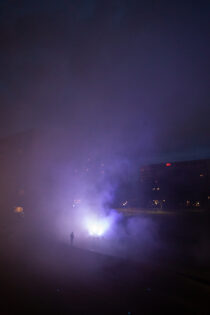|
|
Chorégraphie: Trajal Harrell / avec: Trajal Harrell, Stephen Thompson, Thibault Lac, Rob Fordeyn, Ondrej Vidlar / scénographie: Erik Flatmo / lumières: Jan Maertens / design sonore : Robin Meier / dramaturgie: Gérard Mayen
Coproduction New York Live Arts, Centre National de danse contemporaine Angers, Centre Chorégraphique national de France-Comté (Belfort). Coréalisation Les Spectacles Vivants – Centre Pompidou, Festival d’Automne à Paris, avec le soutien de WpZimmer (Anvers), Workspace (Bruxelles), Pact Zollverein (Essen), Dansens Hus (Stockholm), de l’ONDA, de the Jerome Foundation, the Multi-Arts Production Fund, et the Joyce Mertz-Gilmore Foundation.
With shows in New York, Los Angeles, Paris, Vienna, Santiago de Chile etc. this piece continues to tour and tour and tour…!

Claudia La Rocco for the New York Times on April 27, 2012: By now, just about everyone in the contemporary dance world is familiar with the provocative, involved question behind “Twenty Looks or Paris Is Burning at the Judson Church,” the series Trajal Harrell began in 2009: “What would have happened in 1963 if someone from the ball scene in Harlem had gone downtown to perform alongside the early postmoderns at Judson Church?”
It is, of course, an impossible question, and not one that Mr. Harrell sets out to answer exactly. Rather, the series functions like an engine, driving the choreographer through idiosyncratic explorations, both exacting and unruly, around big, dizzying themes: race, gender, sexuality, culture, history.
The individual dances in the series can be thought of as containers for these interlocking themes, and are distinguished, fittingly, by sizes. (There are five works so far; all stand alone but are most compelling when taken in as parts of a larger whole.) The latest iteration, “Antigone Sr.,” gets the label Large — one it earns, and then some.
An ensemble for five men, including Mr. Harell, “Antigone Sr.” (yes, there is a Jr.) clocked in at just under two and a half intermissionless hours at its premiere on Wednesday night at New York Live Arts. The work’s pacing was sometimes maddening and definitely stamina-testing, but Mr. Harrell — who opened the show by announcing, among other things, that the stage was almost too small for this work — wasn’t going for efficiency.
“We are taking our time,” he declared somewhere in the middle, seated on a low, silver-fabric-covered platform with the miraculously silken performer Thibault Lac.
The two men issued many “We are” sentences, sometimes speaking in tandem, sometimes alone: “Venus and Serena,” “Marc by Marc Jacobs,” “MoMA and the Whitney,” “Cage and Cunningham.”
They ended as the sisters Antigone and Ismene, as Mr. Harrell returned to the ancient Greek tragedy he has increasingly deconstructed throughout the series to fashion his own fierce, ragged mythology — one pieced together from pop culture, theory, voguing, dance history — and, always, the runway. However much in disarray, its denizens are fabulous.
The open stage (the set design is by Erik Flatmo) was carved up by four catwalklike strips of blue and gray paper and studded with three white squares: low daises that the men periodically occupied. Whether sitting in the aisles or among the audience or disappearing backstage, the performers were frequently offstage, reappearing to a smartly eclectic soundtrack of songs in an ever-mutating collage of outré headdresses, dresses, coats and indefinable concoctions, with items continually repurposed and remixed. (The dancers designed the costumes in collaboration with Mr. Harrell, who also created the sound design with Robin Meier.)
As they changed, their personas changed, morphing in ways subtle and not. Mr. Lac, who also performed in “Antigone Jr.,” was joined by Stephen Thompson, Ondrej Vidlar and Rob Fordeyn (a marvel among five striking marvels), with Mr. Harrell serving as something of an outlier. He was sometimes the voluble and humorous M.C., sometimes a grief-stricken, almost creaturely figure.
As “Twenty Looks” has developed, this current of grief has coursed ever more strongly through the series. It has in the past felt more like a found object, something for Mr. Harrell to turn over in his mind as a way to approach and sometimes declaw lofty historical subjects.
The grief in “Antigone Sr.” feels wilder and darker, more intimately tied to personal demons. The show must go on (and on and on), even when it staggers or grinds to a momentary halt, as when Jan Maertens’s terrific lighting design, which sometimes suffuses the stage in a rich haze, occasionally plunges the theater into complete or almost darkness.
Yes, here is the Judson Church legacy, and the Harlem ball legacy. But this, finally, is the House of Harrell.
Related
|








